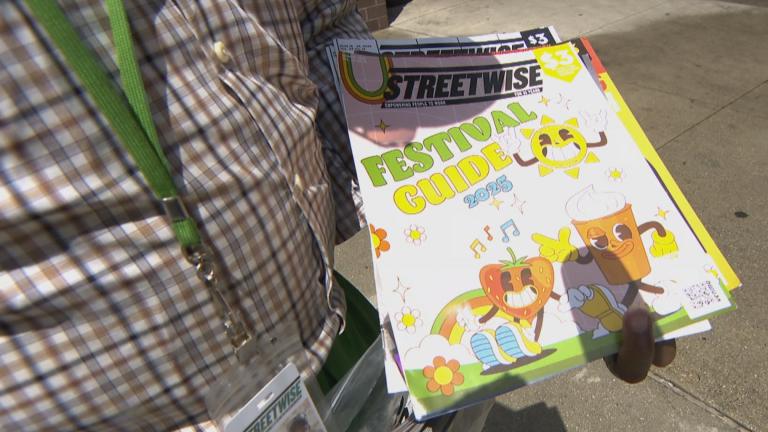|
It’s finally July, Chicago. Enter the warmest month of the year with these stories from WTTW News. |
|
|
|
|
|
|
|
 |
|
Chicago City Hall. (Michael Izquierdo / WTTW News) |
|
Chicago ended 2024 mired in red ink, facing a $161 million deficit after the Chicago Police Department overspent its budget by 10%, leaders of the Chicago Public Schools refused to reimburse the city for making a $175 million pension payment and the city received lower-than-expected corporate tax revenues, officials said Monday.
According to Budget Director Annette Guzman, the city had no choice but to use what officials called its “unassigned fund balance,” to ensure that Chicago’s budget was back in the black by Dec. 31. Guzman spoke during a virtual news conference about the release of Chicago’s 2024 Annual Comprehensive Financial Report.
“A lot of that deficit was reduced by the fact that we had significant reduction in our spending,” Chief Financial Officer Jill Jaworski said. “So we were well under own expenditures and implemented a number of strategies to lower our costs, and they were very effective.”
In other financial news:
For the first time in five years, the amount of money Chicago owes to its four employee pension funds decreased — dropping by approximately $1.3 billion in 2024, according to the city’s audited annual financial report. Chicago still owes $35.9 billion to the four pension funds representing police officers, firefighters, municipal employees and laborers.
The funds designed to pay pensions to Chicago’s police officers and firefighters each have funding levels of approximately 24.5%, while the fund that pays the pensions of municipal workers is 26% funded, according to the annual financial report. The laborers’ fund has the highest funded level, at 42.6%, according to the report. By comparison, other large public pension funds have average funding levels of about 70%.
“These funding levels are, as we all know, not high enough, but it’s a significant turnaround to see them stabilizing and actually going up,” Jaworski said.
|
|
|
|
|
|
|
|
 |
|
A StreetWise vendor shows WTTW News copies of the magazine. (WTTW News) |
|
Whether you find it on street corners or outside the grocery store, StreetWise magazine has been a staple in many Chicago neighborhoods for decades. For the people who sell copies of the magazine, it’s more than just a job. It’s often their way out of challenges such as poverty, homelessness, substance abuse and mental health issues. Now, vendors are telling their own stories in a new book called “Who We Are: Stories From the Chicago StreetWise Community.”
The book is a collection of first-person narratives from several StreetWise vendors who discuss what it’s like selling magazines and the various obstacles they had to overcome to gain stability. Evanston Township High School student Anthony Mateos, the book’s author, interviewed several StreetWise vendors about their experiences and compiled them in an oral history.
Many StreetWise vendors build relationships with their customers and the neighborhoods they sell in. Mateos said the vendors add a unique human element to print media, making it an iconic aspect of local Chicago-area culture.
“So many people know their own vendors in their neighborhoods where they live or maybe in the Loop where they work," Mateos said. "No matter if it’s in the harsh Chicago winters or maybe a heat wave, they’re always out selling the magazine and being happy while doing it.”
Some backstory:
The weekly magazine launched in 1992 with a business model aimed at benefiting vendors, who purchase copies of the weekly magazine for $1.15 and sell them for $3. They keep all of their profits and get access to food, toiletries and mental health resources provided by the organization. Copies are sold by 150 trained vendors.
Read an excerpt from the book here.
|
|
|
|
|
|
|
|
 |
|
A graphic that says "The Piping Plovers of Montrose Beach." (WTTW News) |
|
Chicago’s lakefront is famously open and free. So why is a prime section of Montrose Beach roped off every summer? Because it’s for the birds. Literally.
Piping plovers are tiny shorebirds, about the size of a smartphone but a fraction of the weight. There used to be a few thousand of them, spread across the entire Great Lakes, but then people took away a lot of the beaches where they lived — building houses, hotels, marinas and resorts. By 1986, there were only about a dozen piping plover pairs left in the Great Lakes, all of them nesting in Michigan. The future looked so bleak for our feathered friends that they were officially added to the Endangered Species list.
Fast forward to 2019. Two of these rare creatures turned up on Montrose Beach. Against all odds and logic, a mating pair of piping plovers had landed on one of the most crowded beaches in Chicago and decided to start a family. And so began the city’s love affair with Monty and Rose.
|
|
|
|
|
|
Back in the Day: July 1, 1910 - Comiskey Park Opens |
|
On this day, 115 years ago, the Chicago White Sox played their first game in their new home stadium, Comiskey Park. Charles Comiskey, a former player, was the first owner of the White Sox. He purchased 15 acres of land, which was a decommissioned city landfill, located between 34th and 35th streets, and Wentworth and Shields avenues. Comiskey enlisted architect Zachary Taylor Davis, who designed the stadium that held 32,000 people. It was the third concrete-and-steel stadium in the major leagues, replacing the team's wooden former home in South Side Park. With an extended center field, it was a pitcher-friendly park, benefiting team ace Ed Walsh (who would throw the stadium's first no-hitter in 1911). It was nicknamed "The Baseball Palace of the World," and the White Sox would play there until 1990.
|
 |
|
|
|
This Week’s Staff Recommendations: Local Craft Beers |
|
Every Tuesday, WTTW News staffers highlight their favorite things about Chicago. This week, it’s newsletter producer Josh Terry on Chicago-made beers.
This city thrives on its neighborhood bars and corner taverns. If you see an Old Style sign hanging above a drinking establishment, there’s a good chance you’re in the right place. While crisp, cool and refreshing lagers like Old Style do the trick, some beer drinkers prefer something more local, more interesting and more eclectic. Over the past 30 years, Chicago has become a city full of independent local breweries. While Goose Island led the pack before it was purchased by Anheuser-Busch in 2011, these smaller establishments make a fine alcoholic beverage.
Marz Community Brewing Company
This Bridgeport brewery also has a Bucktown taproom. They boast a collection of eclectic and forward-thinking beers that is best exemplified by their Jungle Boogie ale, a wheat pale brewed with Rooibos tea. My favorite beer in the city. 3630 S. Iron St. and 1950 N. Western Ave.
Hop Butcher for the World
Located in the former Half Acre space in Lincoln Square, these Sandburg-quoting brewers specialize in the hazy and hoppy. While you should check the alcohol percentage when you order their double or triple IPAs, it’s all well-made, tasty and experimental brews. 4257 N. Lincoln Ave.
Moor’s Brewing Co.
This Black-owned craft brewery finally opened a location in Logan Square called Diversey House, featuring food from a “Chopped” champion. 2601 W. Diversey Ave.
Off Color Brewing
With a Lincoln Park taproom, expect unexpected styles, flavors and a decidedly off-kilter sensibility from these mainstays. Sours, saisons, farmhouse beers and other European specialties are these guys’ forte. 1460 N. Kingsbury St. |
|
|
|
|
|
|
What’s your favorite neighborhood to visit on Chicago's West Side? Tell us why. |
|
|
|
Email DailyChicagoan@wttw.com with your responses and your answers might be published. |
|
|
|
 |
|
|
|
5:30 PM | 10:00 PM |
|
|
|
|
Want more WTTW News content? Follow WTTW on Instagram to check in with us daily, go behind-the-scenes, and more. |
|
Newsletter Producer: Josh Terry |
|
|
|
|